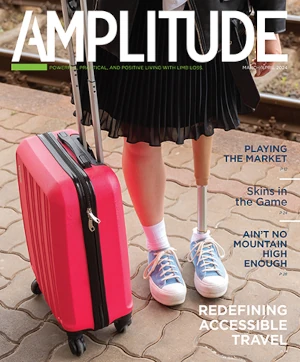
Last week, WebMD published the second half of its two-part investigation into how the COVID pandemic has affected limb loss prevention and treatment. Titled “Amputees Lost in the COVID-19 Shuffle,” the article showed how patterns of amputation, prosthesis uptake, rehabilitation, and long-range care have changed dramatically in the two years since the pandemic began. The news isn’t good, in WebMD’s estimation. One expert told the publication: “The treatment of amputees is in the dark ages, and COVID only made the dark ages darker.”
What’s behind that grim conclusion—and is it too harsh? We summarized the investigation’s topline conclusions and supporting statistics; read them over and decide for yourself. And if you’ve been personally affected by these trends, write and let us know: editor@livingwithamplitude.com.
To read both articles in full, visit WebMD (first article here, second article here).
1. Amputation rates are way up
WebMD cites data from Stanford Healthcare showing a 49 percent increase in amputations between March 2020 and Feb 2021. Other studies conducted earlier in the pandemic showed even sharper increases.
Some of these amputations are direct effects of COVID itself, which can cause clotting that ultimately results in the loss of a limb. However, the spike in amputations has largely been driven by undertreated (or completely untreated) diabetes and vascular disease. Management of these conditions has been disrupted in multiple ways ever since the pandemic began. Some people lost income and/or health insurance, which left them unable to afford insulin and other critical medicines. Others missed medical appointments because they wanted to avoid exposure to the virus, or because their clinic curtailed “nonessential” office visits. Routine testing, preventive treatments such as revascularization, consultations with nutritionists and podiatrists, and other types of limb-preservation care have all declined over the last two years. “There is no doubt that the COVID crisis has resulted in patients delaying their care,” vascular surgeon Lee Kirksey told WebMD. “In some instances, [they lost] their leg as a consequence.”
2. Prosthesis fittings are way down
At the same time more limbs are being lost, fewer prosthetic limbs are being issued. That’s what WebMD found when it compared Veterans Administration data from 2019 to the numbers from 2020 and beyond. The VA’s distribution of prosthetic legs dropped by 23 percent after the pandemic began. This decrease is probably caused by the same forces driving increased rates of limb loss: the contraction of nonessential medical care, and patients’ avoidance of health-care settings that might expose them to infection. One large O&P practice cited in the WebMD article saw a 50 percent decrease in office visits during the first six months of the pandemic. “It wasn’t that the patients weren’t there,” the clinic’s direct said. “It was that they couldn’t be treated.”
More amputations plus fewer prosthetic limbs equals a larger population of amputees who lack mobility, are exposed to high health risks, and struggle to maintain quality of life.
3. Physical therapy for amputees declined sharply
According to the American Physical Therapy Association, 30 percent of physical therapists left the profession between March 2020 and May 2021 due to layoffs, furloughs, or resignations. Among practitioners who remained active, one-fourth were working reduced hours, and nearly half of physical therapy clinics had endured temporary closures.
These staff shortages and service reductions surely help to explain why so many new amputees didn’t transition to a prosthesis: In many cases, physical therapy is a make-or-break step in prosthesis adaptation. “In order to maintain a quality of life with independence . . . [physical therapy] is an absolute must,” vascular surgeon Kelly Kempe told WebMD. Even among amputees who successfully adapted to a prosthesis, many surely suffered unnecessary fatigue, pain, and other consequences due to the lack of physical therapy.
4. Post-surgical rehabilitation came to a standstill
COVID has required more than a million Americans to be hospitalized, and tens of thousands of those patients required long-term care and rehabilitation after discharge. Those patients have overwhelmed in-patient rehab facilities in the last two years, making it more difficult for amputees to get focused, coordinated care after surgery. “Facilities were just not taking amputees,” one rehab specialist told WebMD, “so those patients went home.” Such patients are more susceptible to secondary infection, chronic pain, depression, and other negative outcomes. They’re also less likely to get referred to a prosthetist for a fitting, yet another factor contributing to point #2 above.
In short, COVID has produced a sizeable cohort of amputees who haven’t received the support they need and deserve to regain mobility and independence.
5. Health disparities grew wider
We’ve know for some time that limb loss disproportionately affects Black, Latino, and Native American populations. That trend appears to have accelerated during COVID. In the Stanford Healthcare study (cited above) which showed a 49 percent increase in overall amputation, limb loss among Black patients rose at a much steeper rate of 125 percent. Other studies cited in the WebMD article showed that preventive care for Black and Hispanic individuals with diabetes—already below average—fell further behind during COVID, with falling levels of preventive care, fewer foot-ulcer examinations, and slower uptake of telehealth consultations. “You see a lot of people fall through the cracks,” vascular surgeon LeAnn Chavez told WebMD.
Reversing these trends won’t be easy, added Lee Kirksey of the Cleveland Clinic: “I think over the coming years, we’ll continue to see those consequences play out.”



